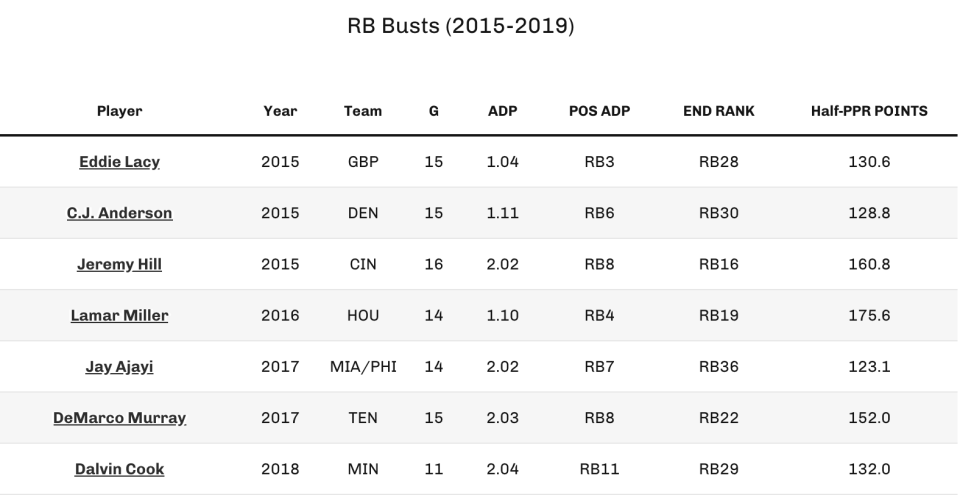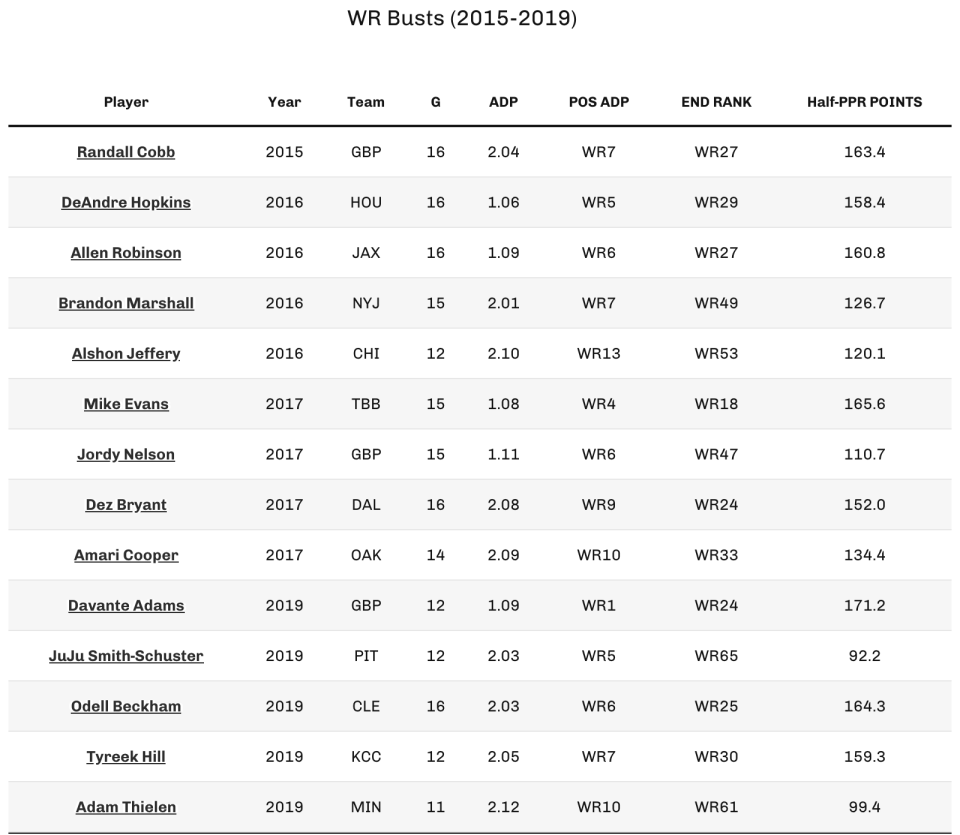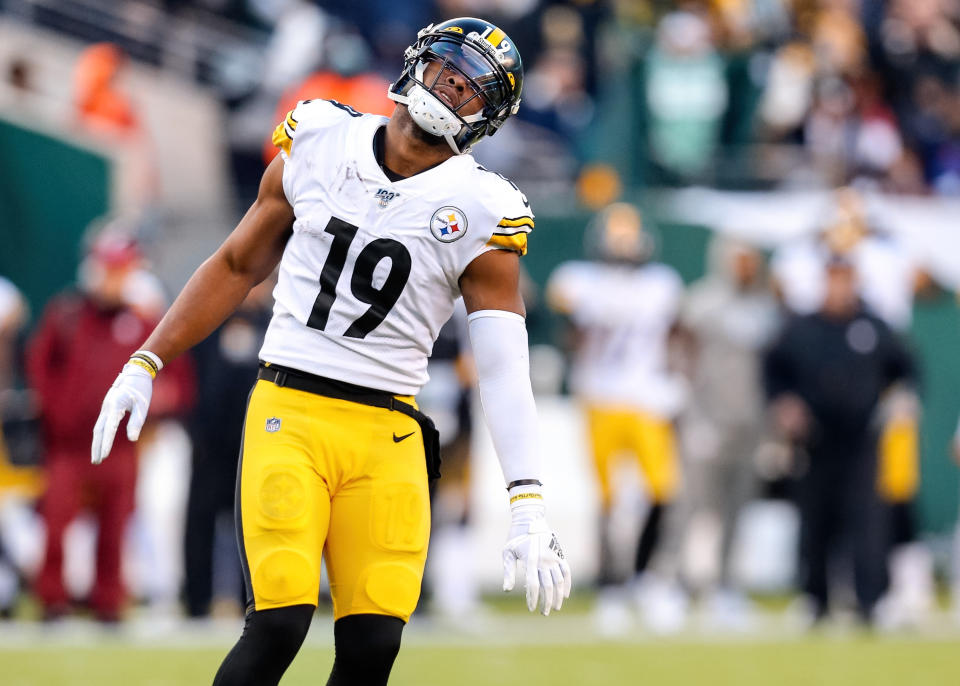How to identify an early round bust-in-the-making so you don't end up drafting one
By Jennifer Eakins, 4for4
Special to Yahoo Sports
As drafters, we expect our first couple picks to be automatic, players who will sit atop any roster at the end of the season. Their contribution should be impactful, one that can be counted on every time they take the football field. Of course, it wouldn’t be fantasy football without an early round player getting injured in training camp or the first couple of weeks of the regular season, sending them to the sidelines for a significant amount of games, or even ending their entire season before it even began.
Sadly, those premature injuries are an inevitable part of the game, something fantasy managers really can’t do anything about. But what about the guys who are drafted within the first few rounds who just don’t pan out as expected? That significant drop in points can easily be a difference-maker throughout the season, considering those players' projections were among the top in the league. If we could somehow predict which players forecasted among the first two rounds would falter, or produce much less than their expectations, we could get an edge on the competition and save ourselves some heartache along the way.
When examining the characteristics of an early round bust, I decided to look at players who were selected in Rounds 1 and 2 from 2015–2019, in an attempt to find any correlations in their seasons. For this article, only WRs and RBs were used, as their sample size is much larger in these rounds, plus elite QBs and TEs very rarely bust unless they’re off the shelf due to injury.
In order to get candidates with true fantasy failures, all players must have been on the field for at least 10 games that season, eliminating players with significant injuries. To qualify as a bust, players must have ended the season at least 10 spots below their positional average draft position (ADP) and/or posted at least 100 points below their projected output.
Running Backs
Only seven backs fit the criteria outlined above from 2015 through the 2019 season, with zero coming from last year:

Poor Offensive Lines, Lack of Targets, or Just Not Very Good?
Looking at 2015, three RBs earned a spot at the under-performer table: Eddie Lacy, C.J. Anderson, and Jeremy Hill. Lacy’s ADP was an inflated 1.04 after Adrian Peterson, Antonio Brown, and LeVeon Bell that season. What should have been an RB3 scenario for the third-year back ended with just 758 rushing yards and five total touchdowns — enough to finish as the RB28 in half-PPR points. The Packers offense was mediocre, finishing 15th in total offense and 27th in yards per play. Perhaps their offensive line was to blame, as Aaron Rodgers was sacked 46 times in 2015, the fifth-most in the league. Lacy’s target deficiency may have also played a part in his underwhelming numbers. With only 28 total, the Packers RB ended 2015 as the 51st-most targeted RB in the NFL, something a top-tier RB rarely finds success with.
C.J. Anderson was on the Super Bowl-winning Broncos offense in 2015, yet ended the season as the RB30 in half-PPR points. Coming off a year where he posted RB10 numbers, Anderson’s ADP was 1.11, the sixth-highest at his position. What went wrong for the third-year back? It appears as though Denver’s porous offensive line could have played a part here, as the tandem of Peyton Manning and Brock Osweiler was sacked 39 times, the 13th-most in the NFL, inhibiting Anderson from gaining any ground. He also only averaged 11.8 touches per game, 42nd among RBs that season.
Jeremy Hill is an interesting one, as he led his offense in rushing yards, was 13th in total touches among RBs, but posted a pedestrian 3.6 rushing yards per attempt. The Bengals were first in the AFC North with a 12-4 record and ranked seventh in total offense in the league. Is it possible he just wasn’t that good at football? I’m going with yes.
Lamar Miller was the only RB in 2016 to bear the bust moniker. As the fourth RB off the board at 1.10, Miller ended the season as the RB19 in total half-PPR points, averaging just 12.5 per contest. Once again, a rough offensive line that allowed the 22nd-most sacks came into play. Having Brock Osweiler under center didn’t exactly help either. Surprisingly, Miller’s 21.4 touches per game were among the most in the league in 2016, yet he couldn’t get it done with a mediocre 4.0 rushing yards per attempt. Like the others, his targets were on the low end, ranking a disappointing 34th among backs that season.
[Visit 4for4, where 92% of subscribers made the playoffs, for more]
In 2017, we saw two RBs not meet the expectations of their elevated ADPs. Jay Ajayi was drafted at the start of the second round, with an ADP of 2.02. He played for two different teams, after being traded from the Dolphins to the Eagles midway through the season. In Miami, Ajayi averaged 19.7 attempts per game only to be reduced to 10 per contest in Philadelphia. Offensive line play was not an issue for either team. It appears that a lack of targets could have been his downfall. With only 34 total targets on the season, Ajayi ranked 46th at his position, as he was thrown to nearly 80 times fewer than the RB target leaders. In turn, he tumbled 29 spots in positional ADP and put up more than 100 half-PPR points fewer than projected at the start of 2017.
Similar to Hill above, DeMarco Murray’s slide seems to be more of a lack of elite talent, as opposed to a system issue. The Titans ranked 15th in rushing and 19th in total offense in 2017, going to the playoffs with a 9-7 record. We can blame some of Murray’s lack of production on his target share, as he ended the season as the RB20 in overall targets, however, he led Tennessee’s backfield, nearly tripling the number of targets that sophomore Derrick Henry saw.
Dalvin Cook was the lone bust across both positions in 2018. He barely makes the cut due to time spent on the sidelines, but the Vikings' RB still managed to play for 11 contests, so he's in. Minnesota's offensive line was an issue that season, allowing Kirk Cousins to get sacked the 18th-most times in the league, which rarely bodes well for a productive backfield. However, Cook's fall from his RB11 ADP down to an RB29 finish can most likely be attributed to his early-season absence due to a hamstring injury. Upon return in Week 9 until the end of the season, Cook averaged 13.6 PPR points a game, good enough for RB12 overall.
Wide Receivers
There were 14 wideouts who earned the chance to hear Maury Povich say "You are not a WR1" from 2015-2019, and here’s a look at how they potentially got there:

Bad Offenses, Bad QBs, and Straight Up Bad Play
Randall Cobb, who was the seventh WR off the board at 2.04, is the lone receiver bust in 2015. Instead of a top-10 finish, the Packers WR ended the year as the WR27 in half-PPR fantasy points, averaging just 10.7 per game. Despite having arguably one of the greatest QBs in the NFL under center, Green Bay’s passing offense ranked 25th in 2015, with Rodgers personally sitting as the QB30 in yards per attempt and 26th in completion percentage. Can we blame Cobb’s slippage on the poor play of Rodgers in 2015? I think I just did. His wideout didn't exactly help, though, as Cobb posted a paltry 51.8 reception yards per game, and his 61.2% catch rate was 124th among pass-catchers.
Four WRs didn’t make the grade in 2016: DeAndre Hopkins, Allen Robinson, Brandon Marshall, and Alshon Jeffery. One thing all four have in common? Brutally bad offenses. In Hopkins’s case, the Texans actually won the AFC South and a playoff game, but still managed to end the season ranked 29th in both team and passing offenses. Brock Osweiler’s 2.9% TD rate was just two away from dead last among QBs, and he owned the basement spot in yards per attempt. Even with Nuk’s insane talent, one can’t overcome dreadful QB play.
While not in the same situation when it came to his team’s end of season result, Robinson met the same fate in the QB department. The Jaguars went 3-13 in 2016, with the NFL’s 25th-ranked team offense. Even all the garbage time theatrics couldn’t elevate Blake Bortles from his post as the third-worst QB both in yards per attempt and completion percentage. ARob dropped 21 spots from his WR6 ADP to where he eventually finished the season in half-PPR points as the WR27.
The Jets were a smidge better record-wise in 2016, yet still struggled offensively. With Ryan Fitzpatrick as the signal-caller, New York’s team offense ranked 30th, with the 27th-ranked passing offense. The NFL’s journeyman extraordinaire sat within the bottom four of almost all passing categories from 2016, including yards per attempt, adjusted yards per passing attempt, TD rate, and completion percentage. Marshall was the seventh WR off the board at 2.01 and brutally finished as the WR49 in half-PPR points. His output was nearly 100 points fewer than projected for a wideout at his ADP.
It seems Jeffery was also carnage stemming from a poor Bears QB committee in 2016. The insipid trio of Matt Barkley, Brian Hoyer, and Jay Cutler combined for a 3.2% TD rate, good enough for 24th among QBs that season. While Jeffery did miss four games due to a banned substance violation, he was still in the lower end of the league in production when on the field. His 4.3 receptions per game ranked 48th, while his 55.3% catch rate came in at a disappointing 157th among receivers.
In 2017 we saw another four WRs within the top 10 taken at their position who failed to finish in that same elite category. Mike Evans is sort of a head-scratcher, as the Bucs' passing offense was ranked fourth in the NFL in 2017. He was the top fantasy producer in his offense, yet he ended the season as the WR18 in half-PPR points. Jameis Winston missed three games, but was fairly effective while on the field, ranking within the top 10 in the majority of QB statistical categories. Evans seems to have gotten in his own way in 2017, as his 52.2% catch rate was 182nd among pass-catchers. Also, despite finishing 11th at his position in targets, he averaged only 4.7 receptions per game.
Jordy Nelson had Brett Hundley tossing the rock for 11 games, translating to a 25th-ranked passing offense for the Packers in 2017. While on the field, Hundley was the fourth-worst in TD rate, second-worst in yards per attempt, and ranked 23rd in completion percentage. Rodgers’ numbers were up to par for his standard of play, but that can only go so far in just seven games. Nelson didn’t exactly make lemonade from the Hundley situation, as his catch rate was a disappointing 60.2% (130th among pass-catchers). His drop from WR6 to WR47 was a huge one, as his final output was over 100 PPR points fewer than projected during draft season.
People are still arguing if Dez Bryant’s fall stemmed from a sophomore slide by QB Dak Prescott or simply a loss in step from the veteran wideout. Prescott’s numbers were serviceable, ranking 13th in completion percentage, 19th in yards per attempt, and 16th in total passing yards. However, Bryant’s numbers weren’t so favorable. His 52.3% catch rate ranked 179th among all pass-catchers, while his 12.1 yards per reception ranked 59th. The targets were there, as Bryant posted WR12 numbers in that department, but in the end, he finished as the WR24 in half-PPR points—15 spots away from his draft day ADP.
Amari Cooper ended the season 23 spots from his WR10 ADP, with an 81-point differential than projected at the start of 2017. What went wrong for the third-year wideout? Derek Carr’s back injury affected him more than he led on, and their 23rd-ranked offense suffered as a result. Carr sat in the lower half of the league in nearly every statistical category, which makes it tough for a WR to achieve elite fantasy status. Cooper was also second to Michael Crabtree in targets with 96 and fourth on the Raiders’ offense in target rate per snap. His 50% catch rate didn't exactly help him, as it put him 190th in the league among receivers.
After taking 2018 off, five wideouts were deemed busts last season based on our criteria. Davante Adams was the first one off draft boards, yet he ended as WR24. Normally a stud regardless of scenario or matchup, Adams missed a month due to turf toe and upon his return, the Packers offense just couldn’t get back on track. According to splits run by The Athletic’s Ben Baldwin, without Adams, Green Bay was third in expected points added (EPA) per play, third in success rate and sixth in drop back EPA, yet with their star receiver, the Packers offense was 18th in EPA per play, 21st in success rate and 19th in drop back EPA. Rodgers and Adams did find success in the postseason, so 2020 should be back on track for Adams’ fantasy production.
Falling 60 spots from WR5 to WR65, JuJu Smith-Schuster broke many fantasy hearts in his first year as the Steelers top dog. He was unable to stay healthy which didn’t help, but the 23-year old was the victim of a really bad QB bounce, having to catch passes from Mason Rudolph and Devlin Hodges for all but two contests. Pittsburgh was 27th in total offense and ranked 31st in passing last season, which is tough to overcome for any WR.

The hype was pretty massive surrounding Odell Beckham and the Browns heading into 2019, and as a result, OBJ was an early second-rounder as WR6. Cleveland’s offense did not produce as expected due to a myriad of reasons, with a subpar offensive line certainly among them. They ranked 23rd at the end of 2019 and their ineptitude had a hand in the Browns offense ending as the 22nd ranked passing offense. Baker Mayfield also took a step back which didn’t help, posting a 59% completion rate (30th in the NFL) and a 4.1% TD rate which was in the lower third of the league.
Both Tyreek Hill and Adam Thielen can be lumped in the injury pile as far as underperforming, but they each saw the field for more than 10 games so they’re in. Hill sustained a clavicle injury early in Week 1 that kept him sidelined until Week 6, then dealt with hamstring issues from Week 11 on. The Chiefs WR1 didn’t clear 72 receiving yards through the final five regular-season games and teams seemed to limit his chances to showcase that crazy breakaway speed.
Thielen dropped from WR10 in ADP to a WR61 finish in half-PPR scoring. He was only in a uniform for 11 games due to a soft-tissue injury as well as an ankle laceration, but the Vikings went way run heavy on the season (fourth in the league) even when he was in the game. His catch rate of 62.5% was 135th among pass catchers, which was not ideal. The 29-year old was a disappointment for those who spent a late-second round pick on him as Thielen failed to crack 100 half-PPR points all season long.
Potential 2020 Busts
Only one name sticks out when looking at players currently being drafted in the first and second rounds, and that's Mike Evans. Not that Tom Brady is necessarily a downgrade at QB, but his arrival signals a system change that may leave Evans with fewer deep-play opportunities. Bruce Arians employs an aggressive, vertical scheme that allowed Evans to produce elite WR numbers, but with Brady under center, the offense will be tempered and the seventh-year WR will need to rely on screens and shorter routes for fantasy production in 2020. We also can't forget about Brady's favorite target Rob Gronkowski and his return to the league as a Buccaneer, which could dip into Evans' total volume.
Bottom Line
If drafting a running back in the first few rounds, which seems on trend again for this season, be sure to check out their offensive line. It’s tough to produce if the offense can’t get a play off and their quarterback is on the ground. Also, targets matter. They always matter.
Wideouts are only as good as the quarterback throwing them the ball, regardless of freakish talent. Sure, athletic ability can get them so far, but to count on the numbers expected from an early round pick, the signal-caller is certainly a factor. Look for solid quarterbacks in respectable offenses.
Let your league mates grab the big names in not-so-great situations and instead focus on players who are set up for success not only physically, but by the competency of their teammates.
This article was originally published at: 4for4
More analysis from 4for4: 3 overvalued QBs | 5 WRs to fade
Stay ahead with 4for4 Fantasy Football's accurate rankings, advanced tools and data-driven content.
A proud alumna of the UGA Grady College of Journalism, Jennifer Eakins has been working in the sports industry for well over a decade. She has had stints with CNN Sports, the Atlanta Hawks and the Colorado Rockies. Her first fantasy football draft took place in 1996 where she selected Ricky Watters with the first overall pick, and she has been a fantasy degenerate ever since.
